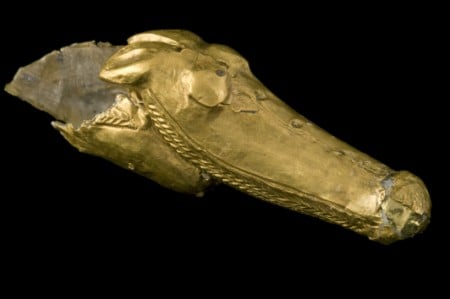Brought to the public by UP Arts, the Mapungubwe Gold Treasures Exhibition contains more than 460 painstakingly restored ancient gold ornaments and jewellery, including the only archaelogical gold rhino figurine in the world .
“The carefully pieced together fragments of gold foil and sheet reveal an astonishing managerie of other ancient gold animals, with gold-beaded necklaces, bracelets and canular coiled anklets among many other enigmatic shapes and forms,” says Sian Tiley Nel, curator of the Mapungubwe Museum at the University of Pretoria
These fascinating and priceless objects were discovered and retrieved from an Iron Age royal burial site of African elite in the early 1930s at Mapungubwe Hill in Limpopo Province, an area that subsequently became South Africa’s 5th world heritage site in 2003.
“The University of Pretoria is proud to be the custodian of this important national cultural heritage. The Mapungubwe gold was the first wrought gold ever discovered in South Africa. The collection is unrivalled in sub-Saharan Africa and comparable to the gold artefacts of the Egyptians, Peruvians and the closer-to-home Ashante gold from West Africa,” says Prof Chris de Beer, acting Vice Chancellor and Principal of the University of Pretoria.
Historically Mapungubwe was one of the first African empires in southern Africa. It abounded with gold and ivory, and traded with Egypt, India, South East Asia, Arabia and China in exchange for glass trade beads. The kingdom ceased to exist by the 14th century.
Tiley Nel says that besides the beauty and historical allure of the exhibition, it reveals a great deal more about early indigenous African mining and technologies, and is likely to alter perceptions about South African prehistory as the ‘new’ ancient objects reveal more than what was previously known.
“The indigenous working of gold evolved out of the spread of knowledge of working with iron, which was introduced into southern Africa by at least the 3rd century AD. Gold became a status obsession during the late Iron Age. It signified African royalty’s status, power and wealth. It adorned bodies and upon death it ornamented graves.” she said.
As farming communities were established and the domestication of cattle, sheep and goats became commonplace, contact with the East Coast developed as communities began to spread. By the end of the first millenium AD, the mining of copper and gold coincided with the economic demand for these commodities by Arabic trade networks operating on the Swahili coast. Many cultural, economic, social and political changes brought about the mining, smithing and smelting of the precious metal.
International funding by Adam Fleming and local conservation skills and technical expertise from The South African Institute for Objects Conservation in Twee Riviere in the Eastern Cape.enabled the conservation and restoration of the Mapungubwe treasures.
This was pioneering work in the sense that no archaeological collection had ever undergone such intensive conservation treatment. In addition, as part of South Africa’s national estate, no archaeological heritage objects (all of which belong to the State) have been so fortunate as to have been cared for and valued.
“After nine months under the bright lights of the conservation laboratory, it seemed as if each fragment had been scrutinised and tried a thousand times. Suddenly, almost as if a long-lost code had been cracked, the centuries of old fragments began to relinquish their secrets under the earnest eyes and patient hands of restorers. It was thrilling to witness these ancient creations recovering their forms and identities, says .Adriaan Botha, registrar of The SA Institute for Objects Conservation.
The Mapungubwe Gold Treasures Exhibition showcases one of South Africa’s greatest gold collections. The exhibition also highlights the importance of the conservation of our heritage objects and brings to public attention the enormous contribution the University of Pretoria as custodian of the collection has made for 76 years.
“This collection includes some of the finest works of art ever produced in southern Africa,” says world-renowned art and antiques expert and auctioneer, Stephan Weltz.

A reconstructed animal head
Copyright © University of Pretoria 2025. All rights reserved.
Get Social With Us
Download the UP Mobile App